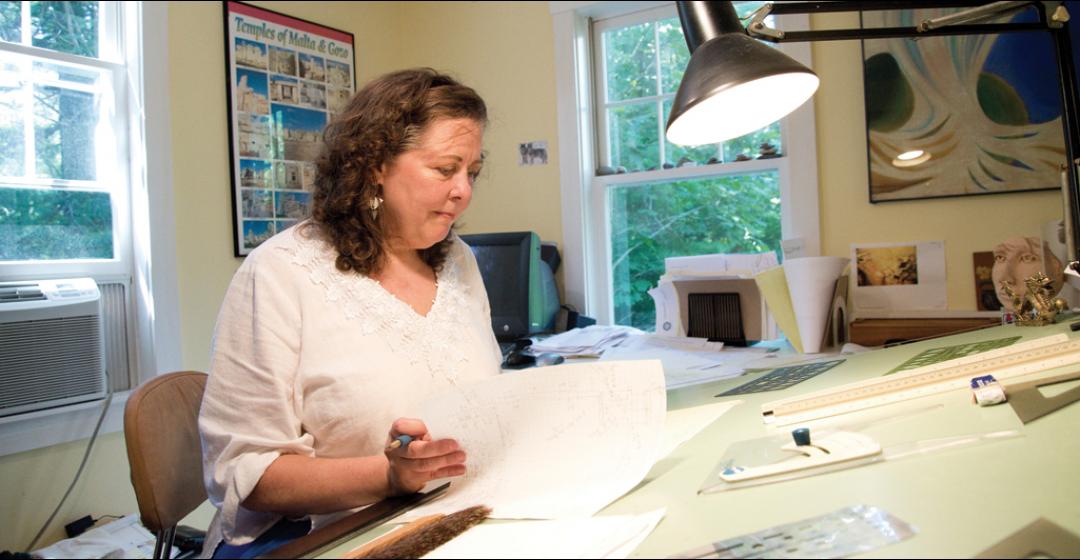You might want to think twice about where you put that coffee table. How you position your furniture, the way you orient your house, even the way you organize your desk can have an impact on your health, your relationships, and your financial success. That’s the concept behind feng shui, an ancient Chinese system relating the flow of energy to spatial arrangement and orientation.
Feng shui – Chinese words for wind and water – has been practiced for centuries, but it wasn’t until the seventies, after President Nixon made his historic trip to China, that the philosophy gained more traction in this country. Over the years, the system has appealed to many Americans – from New Agers to the business community; mogul Donald Trump applies the philosophy in real estate development.
Catherine Finch of Edgartown has been a feng shui consultant for nearly twenty years and an architectural designer for twenty-eight. She explains that feng shui and acupuncture both date from about the same time, and in some ways they are philosophically aligned. They both work with meridians and both direct chi, or the life force. One feng shui technique is to actually drive stakes into the ground to create a positive energy flow – essentially performing acupuncture on the earth.
“Our homes are expressions of ourselves,” Cat explains. “They tell our stories. Our surroundings either support us or deplete us.”
But Cat goes on to explain that what might be good feng shui for one space may be totally wrong for another.
“I look at someone’s home who is just retiring in an entirely different way than someone who’s starting a business or family – someone who wants to step back from the world versus someone who wants to connect with the world.”
For example, if someone is trying to start a business, Cat looks at the approach to their house: Is it easy to get to the front door? Is the entrance around the side and hard to find? The approach to your house is your gateway to the world, and if it’s not obvious it means you will have difficulty making connections. The way you relate to your living space informs how you will relate to the outside world.
But if someone is retiring, they could be looking for a quiet refuge from the world. Cat cites the example of one of her clients who lived in an apartment in back of a main house and was concerned that it had bad feng shui. “In fact,” Cat explains, “it was perfect for her. She could separate herself and rejuvenate – she was done with the workaday world.”
Another focal point for Cat is the bedroom. “The bedroom is important,” she says, “because we spend so much time there. If the bed is behind the door so you can’t see it, it gives a message. The door is where chi enters – where opportunities enter.” Cat says the same holds true for the position of your desk in your office: If you have your back to the door, you’re not open to opportunity.
When looking at the floor plan for a house, one should be conscious of the flow of energy. Sharp angles should be avoided. “Say there’s a corner jutting into a room,” Cat says. “A closet, for instance. I’ll often have the builder soften the edge by cutting it off at a 45-degree angle. People tell me, they can’t believe how different it feels.”
But alternatively, you don’t want the energy to flow too fast. “If you open the front door and right in front of you there’s a door going out, the chi escapes,” Cat explains. “You want it to meander through the house so you can receive the energy, and you can direct it either architecturally or with furniture or plants.”
One of the main tools used in feng shui is the bagua map, which for the purposes of feng shui is essentially an energy map that shows which areas of your surroundings are connected to specific areas of your life. There are different schools of feng shui that each have their own interpretation of the bagua map, but Cat explains how it works in the BTB, or Black Sect Tantric Buddhist, approach to feng shui that she uses.
“The bagua map is nine squares with one in the center. It’s usually drawn as an octagon. The squares represent the areas of life – things like success, relationships, and creativity. The map can be [superimposed] over a property, a building, even over a desk, and it can [help you] analyze the energy. And the arrangements change over time; they’re not stagnant.”
Cat finds that apart from the energy in your home, there’s also something unique about the energy we get just by living on the Vineyard.
“Being on an island lends a very different feel than, say, the mountains do. You can’t really run away from yourself here. Or if you do try to run away, you eventually end up right back where you started – with yourself,” she says. “That can be a good thing; it sort of forces us to evolve. The Island can be a place of regaining one’s center and rejuvenating.”
Sections





